Criminal Justice Report: Labelling Theory in Criminal Justice
VerifiedAdded on 2020/05/16
|7
|1061
|484
Report
AI Summary
This report delves into criminal justice theories, with a specific focus on the labelling theory. It examines how societal reactions and labels influence criminal behavior, differentiating between primary and secondary deviation. The report highlights the importance of laws in defining crime and the impact of societal responses on individuals. It presents a research design using questionnaires to investigate the relationship between a person's character and their likelihood of being labeled as a criminal. The study identifies independent variables such as demographics, age, and gang affiliation. The report also acknowledges limitations, including costs, gang threats, and illiteracy among participants, and provides a comprehensive list of references.
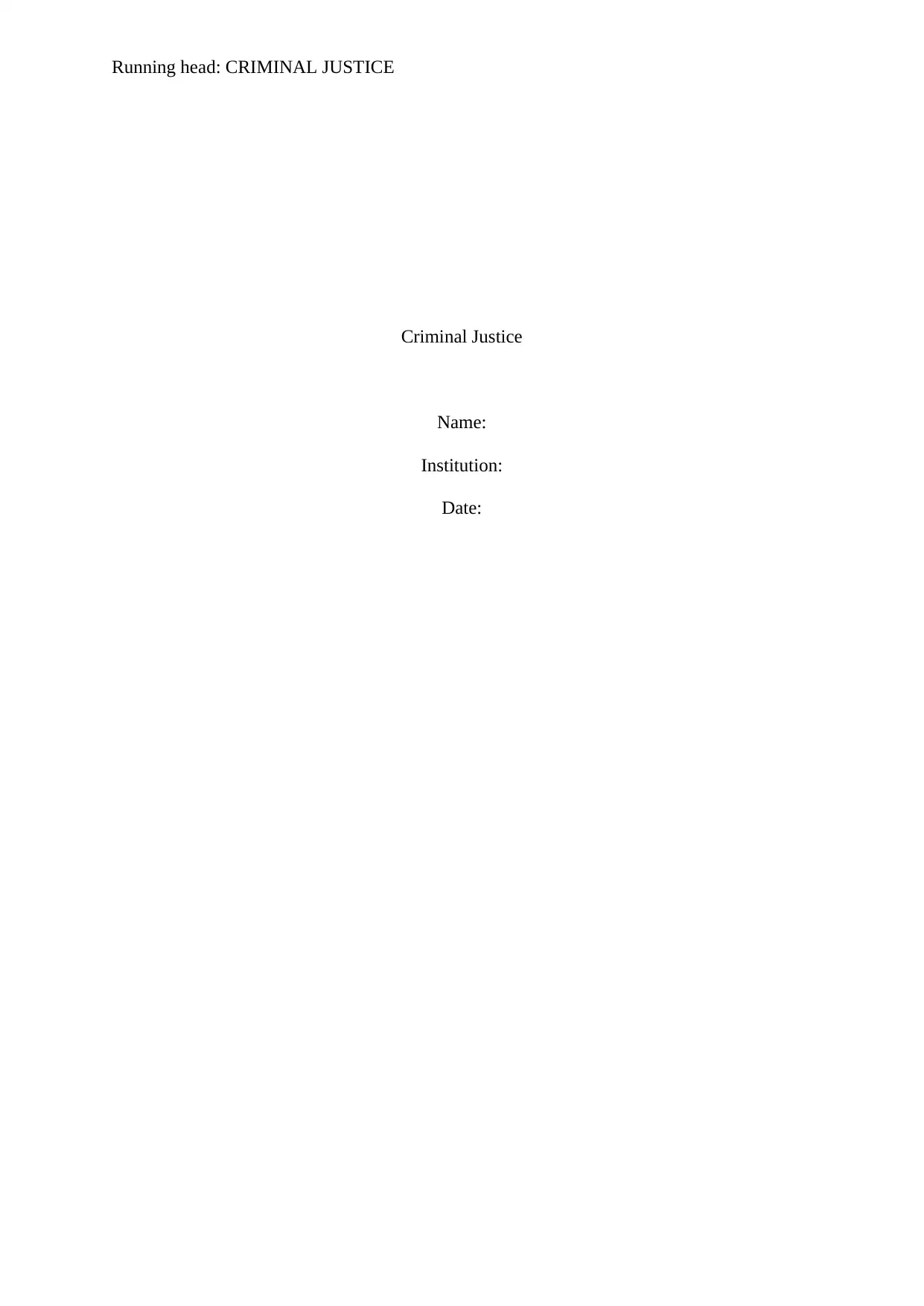
Running head: CRIMINAL JUSTICE
Criminal Justice
Name:
Institution:
Date:
Criminal Justice
Name:
Institution:
Date:
Paraphrase This Document
Need a fresh take? Get an instant paraphrase of this document with our AI Paraphraser
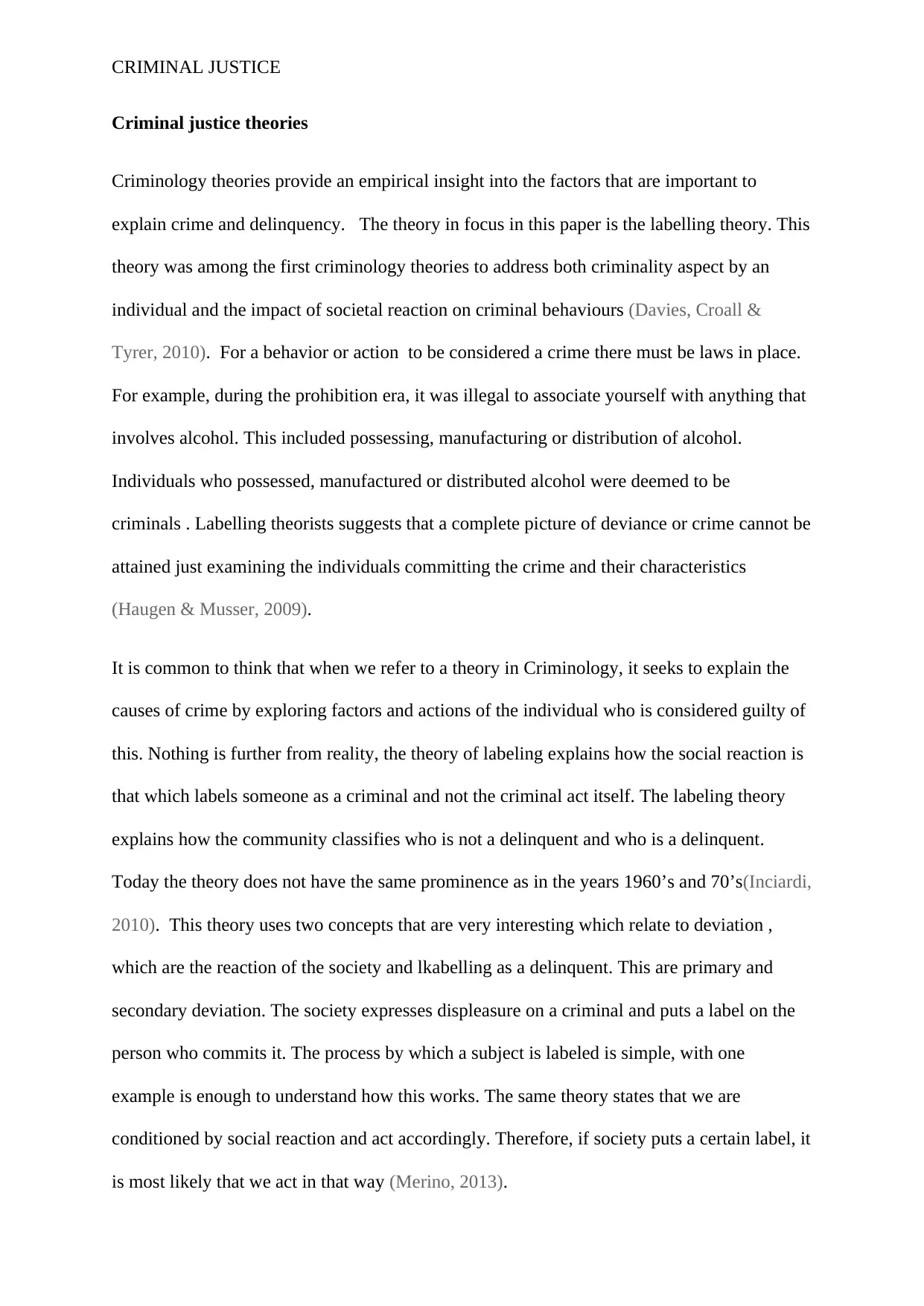
CRIMINAL JUSTICE
Criminal justice theories
Criminology theories provide an empirical insight into the factors that are important to
explain crime and delinquency. The theory in focus in this paper is the labelling theory. This
theory was among the first criminology theories to address both criminality aspect by an
individual and the impact of societal reaction on criminal behaviours (Davies, Croall &
Tyrer, 2010). For a behavior or action to be considered a crime there must be laws in place.
For example, during the prohibition era, it was illegal to associate yourself with anything that
involves alcohol. This included possessing, manufacturing or distribution of alcohol.
Individuals who possessed, manufactured or distributed alcohol were deemed to be
criminals . Labelling theorists suggests that a complete picture of deviance or crime cannot be
attained just examining the individuals committing the crime and their characteristics
(Haugen & Musser, 2009).
It is common to think that when we refer to a theory in Criminology, it seeks to explain the
causes of crime by exploring factors and actions of the individual who is considered guilty of
this. Nothing is further from reality, the theory of labeling explains how the social reaction is
that which labels someone as a criminal and not the criminal act itself. The labeling theory
explains how the community classifies who is not a delinquent and who is a delinquent.
Today the theory does not have the same prominence as in the years 1960’s and 70’s(Inciardi,
2010). This theory uses two concepts that are very interesting which relate to deviation ,
which are the reaction of the society and lkabelling as a delinquent. This are primary and
secondary deviation. The society expresses displeasure on a criminal and puts a label on the
person who commits it. The process by which a subject is labeled is simple, with one
example is enough to understand how this works. The same theory states that we are
conditioned by social reaction and act accordingly. Therefore, if society puts a certain label, it
is most likely that we act in that way (Merino, 2013).
Criminal justice theories
Criminology theories provide an empirical insight into the factors that are important to
explain crime and delinquency. The theory in focus in this paper is the labelling theory. This
theory was among the first criminology theories to address both criminality aspect by an
individual and the impact of societal reaction on criminal behaviours (Davies, Croall &
Tyrer, 2010). For a behavior or action to be considered a crime there must be laws in place.
For example, during the prohibition era, it was illegal to associate yourself with anything that
involves alcohol. This included possessing, manufacturing or distribution of alcohol.
Individuals who possessed, manufactured or distributed alcohol were deemed to be
criminals . Labelling theorists suggests that a complete picture of deviance or crime cannot be
attained just examining the individuals committing the crime and their characteristics
(Haugen & Musser, 2009).
It is common to think that when we refer to a theory in Criminology, it seeks to explain the
causes of crime by exploring factors and actions of the individual who is considered guilty of
this. Nothing is further from reality, the theory of labeling explains how the social reaction is
that which labels someone as a criminal and not the criminal act itself. The labeling theory
explains how the community classifies who is not a delinquent and who is a delinquent.
Today the theory does not have the same prominence as in the years 1960’s and 70’s(Inciardi,
2010). This theory uses two concepts that are very interesting which relate to deviation ,
which are the reaction of the society and lkabelling as a delinquent. This are primary and
secondary deviation. The society expresses displeasure on a criminal and puts a label on the
person who commits it. The process by which a subject is labeled is simple, with one
example is enough to understand how this works. The same theory states that we are
conditioned by social reaction and act accordingly. Therefore, if society puts a certain label, it
is most likely that we act in that way (Merino, 2013).
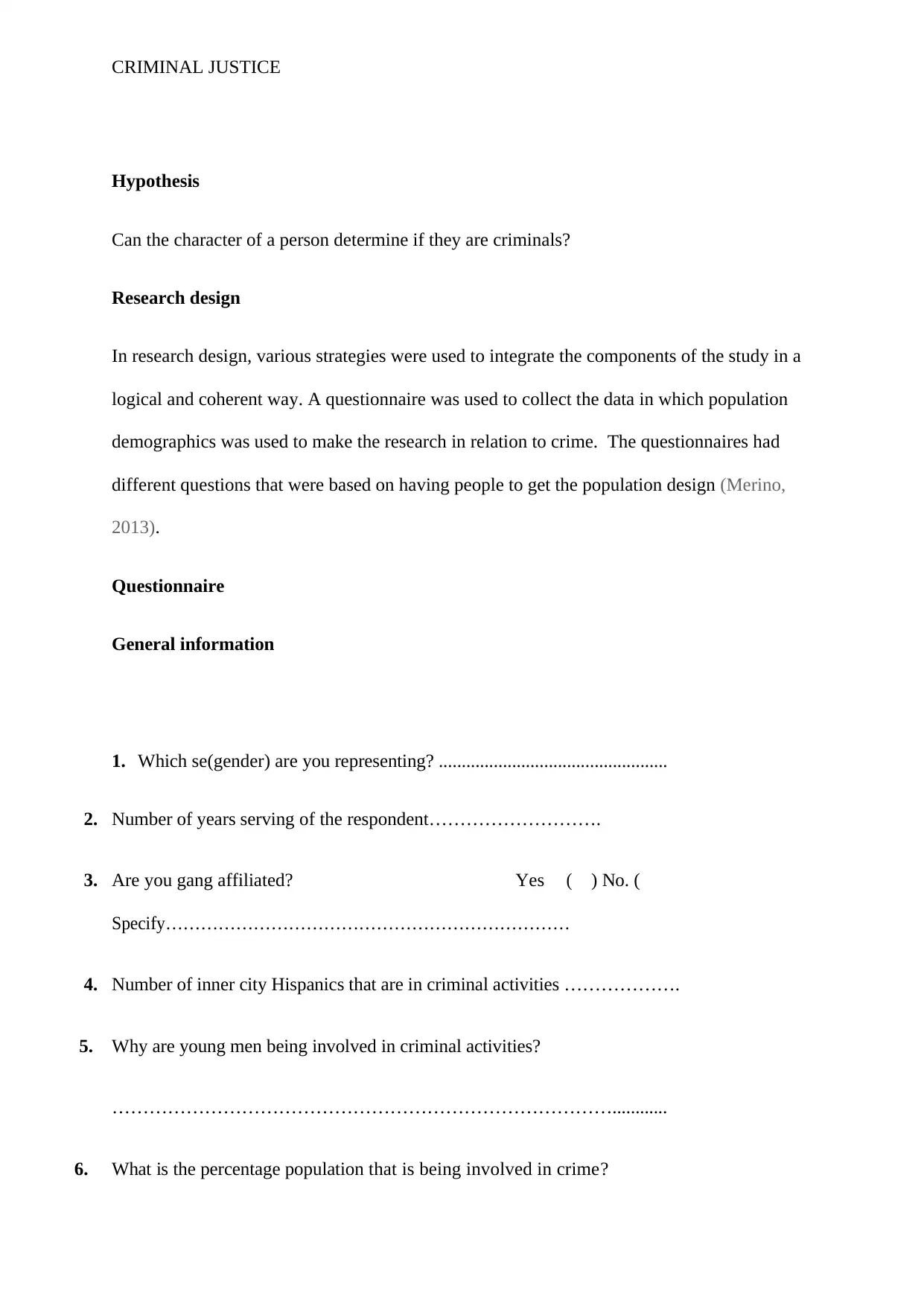
CRIMINAL JUSTICE
Hypothesis
Can the character of a person determine if they are criminals?
Research design
In research design, various strategies were used to integrate the components of the study in a
logical and coherent way. A questionnaire was used to collect the data in which population
demographics was used to make the research in relation to crime. The questionnaires had
different questions that were based on having people to get the population design (Merino,
2013).
Questionnaire
General information
1. Which se(gender) are you representing? ..................................................
2. Number of years serving of the respondent……………………….
3. Are you gang affiliated? Yes ( ) No. (
Specify……………………………………………………………
4. Number of inner city Hispanics that are in criminal activities ……………….
5. Why are young men being involved in criminal activities?
………………………………………………………………………............
6. What is the percentage population that is being involved in crime?
Hypothesis
Can the character of a person determine if they are criminals?
Research design
In research design, various strategies were used to integrate the components of the study in a
logical and coherent way. A questionnaire was used to collect the data in which population
demographics was used to make the research in relation to crime. The questionnaires had
different questions that were based on having people to get the population design (Merino,
2013).
Questionnaire
General information
1. Which se(gender) are you representing? ..................................................
2. Number of years serving of the respondent……………………….
3. Are you gang affiliated? Yes ( ) No. (
Specify……………………………………………………………
4. Number of inner city Hispanics that are in criminal activities ……………….
5. Why are young men being involved in criminal activities?
………………………………………………………………………............
6. What is the percentage population that is being involved in crime?
⊘ This is a preview!⊘
Do you want full access?
Subscribe today to unlock all pages.

Trusted by 1+ million students worldwide
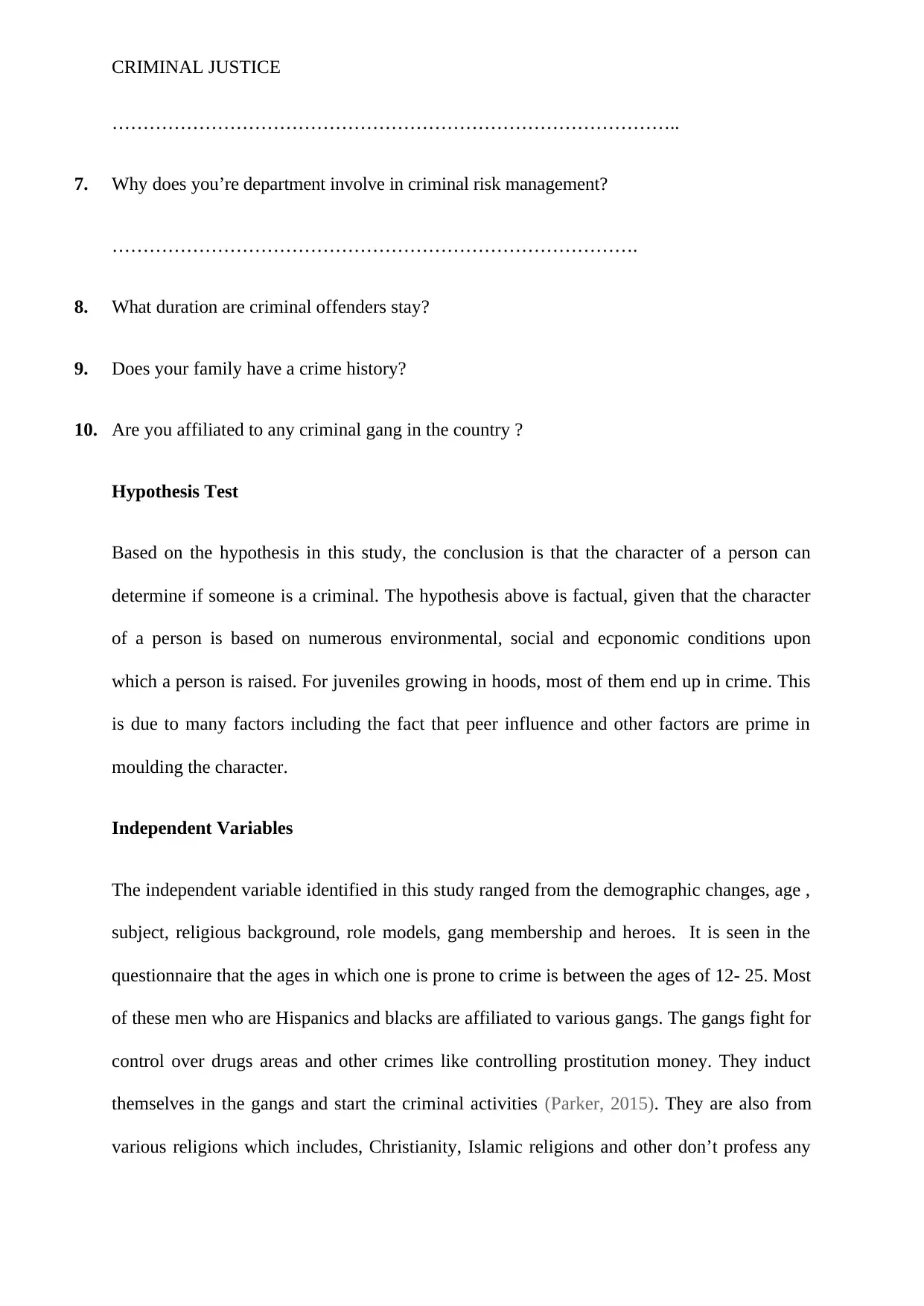
CRIMINAL JUSTICE
………………………………………………………………………………..
7. Why does you’re department involve in criminal risk management?
………………………………………………………………………….
8. What duration are criminal offenders stay?
9. Does your family have a crime history?
10. Are you affiliated to any criminal gang in the country ?
Hypothesis Test
Based on the hypothesis in this study, the conclusion is that the character of a person can
determine if someone is a criminal. The hypothesis above is factual, given that the character
of a person is based on numerous environmental, social and ecponomic conditions upon
which a person is raised. For juveniles growing in hoods, most of them end up in crime. This
is due to many factors including the fact that peer influence and other factors are prime in
moulding the character.
Independent Variables
The independent variable identified in this study ranged from the demographic changes, age ,
subject, religious background, role models, gang membership and heroes. It is seen in the
questionnaire that the ages in which one is prone to crime is between the ages of 12- 25. Most
of these men who are Hispanics and blacks are affiliated to various gangs. The gangs fight for
control over drugs areas and other crimes like controlling prostitution money. They induct
themselves in the gangs and start the criminal activities (Parker, 2015). They are also from
various religions which includes, Christianity, Islamic religions and other don’t profess any
………………………………………………………………………………..
7. Why does you’re department involve in criminal risk management?
………………………………………………………………………….
8. What duration are criminal offenders stay?
9. Does your family have a crime history?
10. Are you affiliated to any criminal gang in the country ?
Hypothesis Test
Based on the hypothesis in this study, the conclusion is that the character of a person can
determine if someone is a criminal. The hypothesis above is factual, given that the character
of a person is based on numerous environmental, social and ecponomic conditions upon
which a person is raised. For juveniles growing in hoods, most of them end up in crime. This
is due to many factors including the fact that peer influence and other factors are prime in
moulding the character.
Independent Variables
The independent variable identified in this study ranged from the demographic changes, age ,
subject, religious background, role models, gang membership and heroes. It is seen in the
questionnaire that the ages in which one is prone to crime is between the ages of 12- 25. Most
of these men who are Hispanics and blacks are affiliated to various gangs. The gangs fight for
control over drugs areas and other crimes like controlling prostitution money. They induct
themselves in the gangs and start the criminal activities (Parker, 2015). They are also from
various religions which includes, Christianity, Islamic religions and other don’t profess any
Paraphrase This Document
Need a fresh take? Get an instant paraphrase of this document with our AI Paraphraser
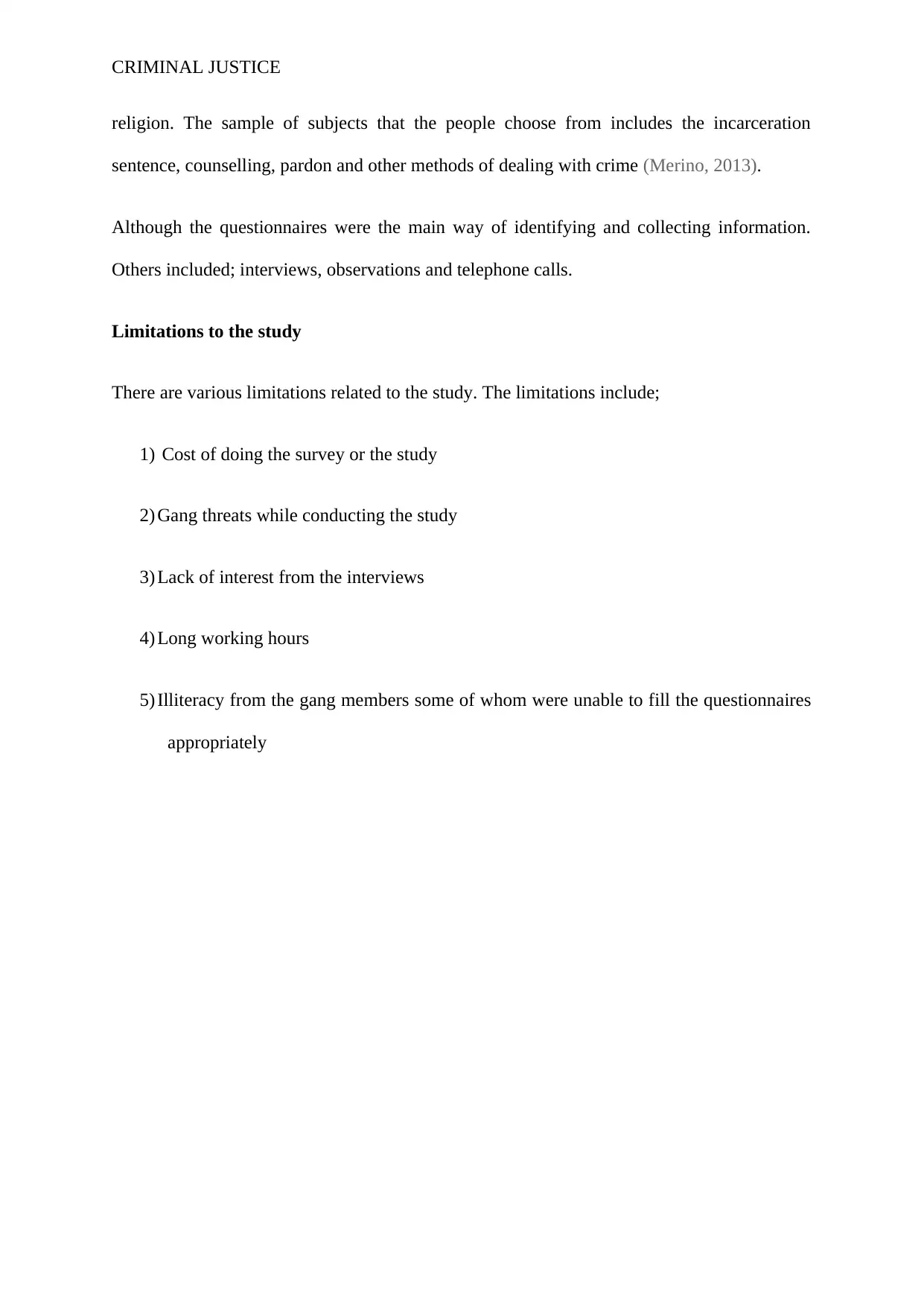
CRIMINAL JUSTICE
religion. The sample of subjects that the people choose from includes the incarceration
sentence, counselling, pardon and other methods of dealing with crime (Merino, 2013).
Although the questionnaires were the main way of identifying and collecting information.
Others included; interviews, observations and telephone calls.
Limitations to the study
There are various limitations related to the study. The limitations include;
1) Cost of doing the survey or the study
2) Gang threats while conducting the study
3) Lack of interest from the interviews
4) Long working hours
5) Illiteracy from the gang members some of whom were unable to fill the questionnaires
appropriately
religion. The sample of subjects that the people choose from includes the incarceration
sentence, counselling, pardon and other methods of dealing with crime (Merino, 2013).
Although the questionnaires were the main way of identifying and collecting information.
Others included; interviews, observations and telephone calls.
Limitations to the study
There are various limitations related to the study. The limitations include;
1) Cost of doing the survey or the study
2) Gang threats while conducting the study
3) Lack of interest from the interviews
4) Long working hours
5) Illiteracy from the gang members some of whom were unable to fill the questionnaires
appropriately
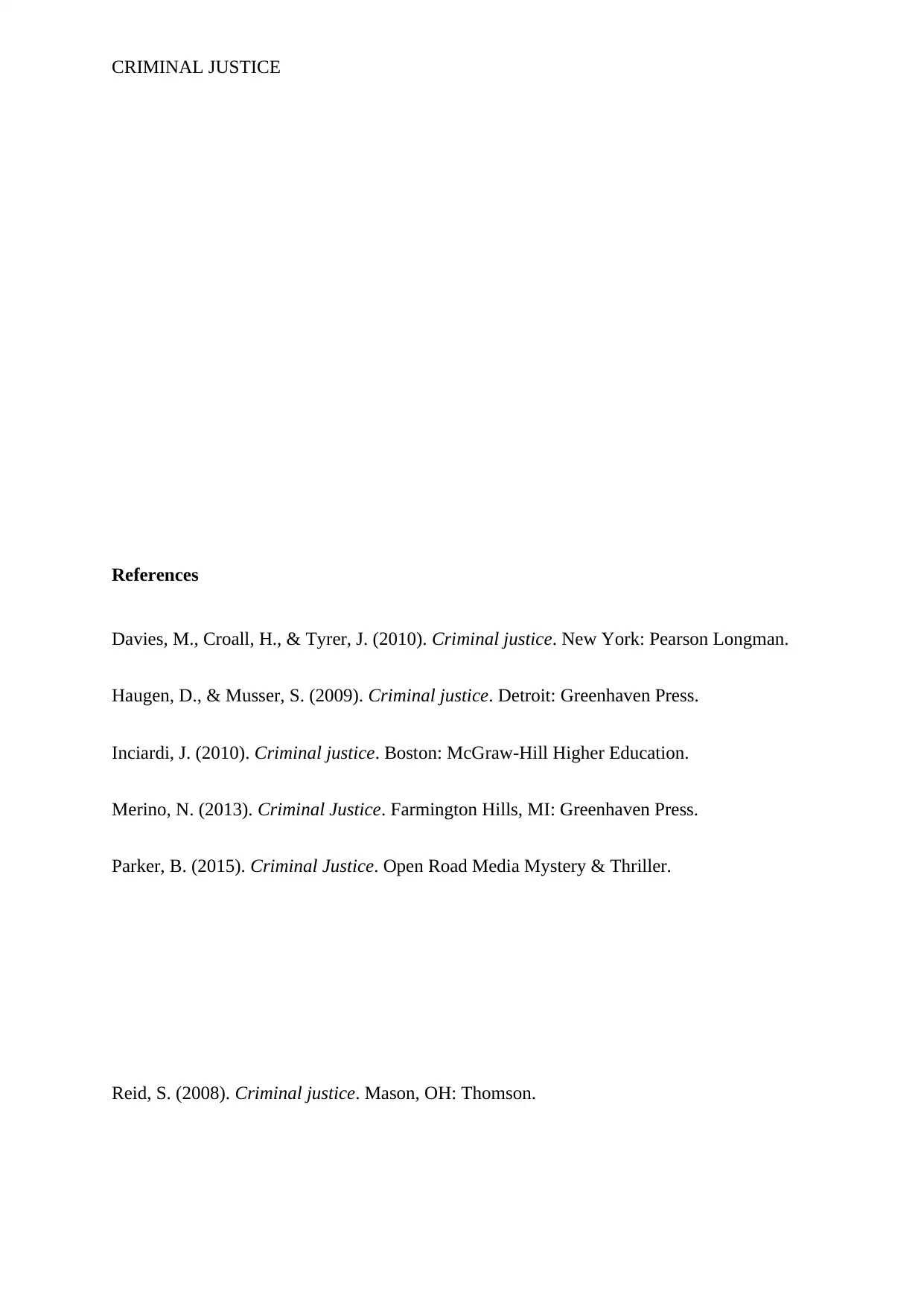
CRIMINAL JUSTICE
References
Davies, M., Croall, H., & Tyrer, J. (2010). Criminal justice. New York: Pearson Longman.
Haugen, D., & Musser, S. (2009). Criminal justice. Detroit: Greenhaven Press.
Inciardi, J. (2010). Criminal justice. Boston: McGraw-Hill Higher Education.
Merino, N. (2013). Criminal Justice. Farmington Hills, MI: Greenhaven Press.
Parker, B. (2015). Criminal Justice. Open Road Media Mystery & Thriller.
Reid, S. (2008). Criminal justice. Mason, OH: Thomson.
References
Davies, M., Croall, H., & Tyrer, J. (2010). Criminal justice. New York: Pearson Longman.
Haugen, D., & Musser, S. (2009). Criminal justice. Detroit: Greenhaven Press.
Inciardi, J. (2010). Criminal justice. Boston: McGraw-Hill Higher Education.
Merino, N. (2013). Criminal Justice. Farmington Hills, MI: Greenhaven Press.
Parker, B. (2015). Criminal Justice. Open Road Media Mystery & Thriller.
Reid, S. (2008). Criminal justice. Mason, OH: Thomson.
⊘ This is a preview!⊘
Do you want full access?
Subscribe today to unlock all pages.

Trusted by 1+ million students worldwide

CRIMINAL JUSTICE
1 out of 7
Related Documents
Your All-in-One AI-Powered Toolkit for Academic Success.
+13062052269
info@desklib.com
Available 24*7 on WhatsApp / Email
![[object Object]](/_next/static/media/star-bottom.7253800d.svg)
Unlock your academic potential
Copyright © 2020–2025 A2Z Services. All Rights Reserved. Developed and managed by ZUCOL.





